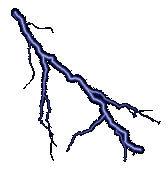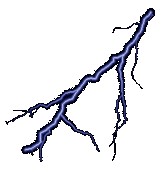
Skywarn**


WHY do N-W-S meteorologists need severe weather reports from weather spotters during a severe weather ? (They need to know what the storms are doing at ground level. The Doppler Radar cannot detect what is happening at the ground...it was designed to look into the heart of storm clouds, and their surroundings, to detect wind currents and other storm-structure clues that suggest a storm is or will become severe.
Spotter reports allow meteorologists to correlate what they see on radar with what is actually happening. In some cases, the storm may "look" severe on Doppler radar, but in reality, it isn't. The meteorologist is learning in real-time. By the way, a storm is severe if it produces hail at least 3/4 inch in diameter, and/or damaging winds at least 58 mph, or a tornado.
These are known as severe weather events. Flash floods are another classic severe weather event.) The greater the lead time of the warnings, the greater the chances that people can seek shelter. Doppler radar cannot detect what kind of a weather hazard is occurring at the ground, it needs reports from "weather spotters." All of these people and organizations constitute the weather spotter networks that are "activated" just prior to severe weather episodes.
In order for weather spotters to pass onto the NWS accurate and timely severe weather reports they need information on what to look for, and how to differentiate between the real and false severe storms, funnel clouds, tornadoes, etc. As with anything else, if one wants to be an effective spotter, they must attend several spotter classes.
This class is usually given by the NWS in your area. If you are interested in taking this class contact the National Weather Service in your area.


**The information on this page is not sufficient to qualify you as a SKYWARN spotter. Rather, it is provided as a reference source to supplement the National Weather Service's spotter training film and slide series.
Spotter Reporting Procedures
From radio-equipped vehicles, report severe weather observations to a central collection point and request them to relay the report to the National Weather Service.
Law enforcement and Civil Defense spotters--report to the National Weather Service via NAWAS, radio, or other direct communications links as prescribed by your Emergency Operations Plan.
When the telephone is
your only communications method, call your primary or alternate contact and ask
them to relay your report to the National Weather Service. If you are unable to
reach the primary or alternate contact, place an emergency call through the
telephone operator to the National Weather Service. If the call is long
distance, it can be made collect. Report promptly as the storm may interrupt
communications.


REPORT BRIEFLY:
What
you have seen: wall cloud, tornado, funnel cloud, waterspout, heavy rain,
etc.
Where
you saw it: the direction and distance from a known location,
e.g., 3 miles south of Beltsville.
When
you saw it: make sure you note the time of your observation.
What
it was doing: describe the storm's direction and speed of travel, size and
intensity, and destructiveness. Include any amount of uncertainty as needed,
i.e., "funnel cloud; no debris visible at the surface but too far away to be
certain it is not on the ground."
Identify
yourself and your location. Give spotter code number if one has been assigned.
Report:
1. Tornado, Funnel Cloud, Waterspout, or Wall Cloud.
2. Hail, 1/4 inch or
larger
3. Damaging Winds (usually 50 mph or greater)
4. Flash
Flooding
5 Rain, (rate of 1 inch per hour or more)
Additional Tips for Skywarn Spotters
The first sign of a tornado may not be a funnel at the cloud base. Your first clue may be debris or dust at the surface, so be alert to events at ground level, as well as in the clouds. At night, lightning flashes can aid in identifying the Rain Free Base, Wall Cloud, and Precipitation Area. Although a loud roar is frequently associated with a tornado, strong straight-line winds can also produce such a sound.
If you spot from a fixed location, use a map to determine distances and directions to known landmarks such as water towers, TV towers, etc. This will help you estimate distance and direction in your reports. Mobile spotters should always have up-to-date maps and be familiar with the area in which they are operating.
When available, use binoculars to look for rotation and other cloud features. Once you spot a funnel, tornado, or wall cloud, be alert for the formation of others in the area.
If you find yourself in large hail, remember you are in or near the area where tornado formation is most likely in a tornadic thunderstorm.
Always follow the basic safety rules. In open country, a spotter may be able to use his knowledge of the tornado's motion and available escape routes to drive away from the tornado safely. In urban area this is usually not possible because of traffic congestion. Make certain your family knows what to do in tornado emergencies as you may not be available to assist or direct them.


Spotter Aids
|
pea size |
1/4 inch |
|
marble size |
1/2 inch |
|
dime size |
3/4 inch |
|
quarter size |
1 inch |
|
golf ball size |
1.75 inch |
|
baseball size |
2.75 |
|
25-31 |
Large branches in motion; whistling heard in telephone wires |
|
32-38 |
Whole trees in motion; inconvenience felt walking against wind |
|
39-54 |
Twigs break off trees; wind generally impedes progress |
|
55-72 |
Damage to chimneys and TV antenna; pushes over shallow rooted trees |
|
73-112 |
Peels surface off roofs; windows broken; light trailer houses pushed or overturned; moving automobiles pushed off roads |
|
113-157 |
Roofs torn off houses; weak buildings and trailer houses destroyed; large trees snapped and uprooted |
|
158 & up |
Severe damage; cars lifted off ground |


